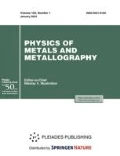Abstract
Regularities of the formation of the phase and structural state and mechanical characteristics of vacuum-arc coatings produced by the evaporation of Zr-Ti-Si-N targets in a reactive nitrogen atmosphere have been studied. For the targets of compositions Zr 92.0 wt %, Ti 3.9 wt %, Si 4.1 wt %, and Zr 64.2 wt %, Ti 32.1 wt %, Si 3.7 % at a working pressure of the nitrogen atmosphere of 0.1-0.8 Pa and a potential at the substrate of −100 and −200 V, the formation of a single-phase crystalline state of the coatings (nitride of the solid solution of the components of the target) has been established. The size of crystallites is in the nanometer range (25–85 nm). An increase in the size of crystallites in the direction of the incidence of the film-forming particles (perpendicular to the growth plane) is favored by an increase in the bias potential from −100 to −200 V. The low heat conductivity of the metallic (Ti and Zr) components of the target leads to a significant content of a droplet phase when using the direct-flow regime of the vacuum-arc deposition and requires the employment of a technological scheme with a separation of the film-forming beams to increase the homogeneity of the high mechanical properties of the coatings. The use of film-forming beams separated from the droplet phase makes it possible to increase the homogeneity of the surface morphology of the coatings with the retention of a large index of plasticity (H/E = 0.8–0.9) and high hardness (33–37 GPa) of the material of the coating.
Similar content being viewed by others
References
O. Knotek, T. Leyendeker, and F. Jungblut, “On the Properties of Physically Vapour-Deposited Ti-Al-V-N Coatings,” Thin Solid Films 153, 83–90 (1987).
F. Kauffmann, G. Dehm, V. Schier, A. Schattke, T. Beck, S. Lang, and E. Arzt, “Microstructural Size Effects on the Hardness of Nanocrystalline TiN/Amorphous-SiNx Coatings Prepared by Magnetron Sputtering,” Thin Solid Films 473, 114–122 (2005).
H. Soderberg, M. Oden, J. M. Molina-Aldareguia, and L. Hultman, “Nanostructure Formation during Deposition of TiN/SiNx Nanomultilayer Films by Reactive Dual Magnetron Sputtering,” J. Appl. Phys. 97, 114327 (2005).
I. Grimberg, V. N. Zhitomirky, R. L. Boxman, and S. Goldsmith, “Multicomponent Ti-Zr-N and Ti-Nb-N Coatings Deposited by Vacuum Arc,” Surf. Coat. Tech. 108–109, 154–159 (1998).
O. Knotek, W. D. Munz, and T. Leyendeker, “Industrial Deposition of Binary, Ternary and Quaternary Nitrides of Titanium, Zirconium and Aluminium,” J. Vac. Sci. Technol. A 5(4), 2173–2179 (1987).
D. Y. Wang, C. L. Cang, C. H. Hsu, and H. N. Lin, “Synthesis of (Ti, Zr)N Hard Coatings by Unbalanced Magnetron Sputtering,” Surf. Coat. Technol. 130, 64–68 (2000).
A. P. Shpak, A. I. Nakonechnaya, Yu. A. Kunitskii, and O. V. Sobol’, Mechanical Properties of Titanium-Based Coatings (PTs IMF NANU, Kiev, 2005) [in Russian].
I. I. Aksenov, Vacuum Arc in Erosion Plasma Sources (NNTs KhFTI, Kharkov, 2005) [in Russian].
L. S. Palatnik, M. Ya. Fuks, and V. M. Kosevich, Mechanism of Formation and the Substructure of Condensed Films (Nauka, Moscow, 1972) [in Russian].
O. V. Sobol, E. A. Sobol, L. I. Gladkikh, and A. N. Gladkikh, “On the Mechanism of β-WC-α-W2C Transformation under Annealing in Magnetron-Sputtering Tungsten Carbide Films,” Funct. Mater. 9(3), 486–490 (2002).
O. V. Sobol’, A. D. Pogrebnyak, P. V. Turbin, et al., “Structure and Properties of Nanocrystalline Coatings in Zr-Ti-Si-N System Obtained by Vacuum Arc Evaporation with High-Frequency Stimulation,” Visn. Kharkov. Nat. Univ., Ser. Fiz., No. 914, 48–53 (2010).
O. V. Sobol’, “Phase Composition, Structure, and Stressed State of Tungsten Films Produced by Ion-Plasma Sputtering,” Fiz. Met. Metalloved. 91(1), 63–71 (2001) [Phys. Met. Metallogr. 91 (1), 60–68 (2001)].
L. I. Mirkin, X-ray Diffraction Control of Engineering Materials: A Handbook (Mashinostroenie, Moscow, 1979) [in Russian].
C. Y. Ho, R. W. Powel, and P. E. Liley, “Thermal Conductivity of the Elements,” J. Phys. Chem. Ref. Data 1(2), 279–425 (1972).
A. P. Shpak, O. V. Sobol’, V. A. Tatarenko, Yu. A. Kunitskii, M. Yu. Barabash, D. S. Leonov, and V. A. Dement’ev, “Regularities of the Formation of Nonequilibrium Structure of Ion-Plasma Condensates of Quasi-Binary Carbide and Boride Systems,” Metallofiz. Noveishie Tekhnol. 30(4), 525–535 (2008).
O. V. Sobol’, “Mechanism of Formation of the Phase and Structural State of Condensates Produced by Ion Sputtering,” Fiz. Inzhener. Poverkhn. 6(1-2), 20–36 (2008).
A. D. Pogrebnjak, O. V. Sobol, V. M. Beresnev, P. V. Turbin, G. V. Kirik, N. A. Makhmudov, M. V. Il’yashenko, A. P. Shypylenko, M. V. Kaverin, M. Yu. Tashmetov, and A. V. Pshyk, “Phase Composition, Thermal Stability, Physical and Mechanical Properties of Superhard on Base Zr-Ti-Si-N Nanocomposite Coatings,” in Nanostructured Materials and Nanotechnologies IV: Ceramic Engineering and Science Proceedings 31(7), 127–138 (2010).
O. V. Sobol’, E. A. Sobol’, and A. A. Podtelezhnikov, “Peculiarities of Texture Formation in Coatings Obtained from Ion-Plasma Beams,” Funct. Mater. 6(5), p. 868–876 (1999).
A. D. Pogrebnyak, A. P. Shpak, N. A. Azarenkov, and V. M. Beresnev, “Structures and Properties of Hard and Superhard Nanocomposite Coatings,” Usp. Fiz. Nauk 179(1), 34–63 (2009) [Phys.-Usp. 52 (1), 29–54 (2009)].
V. M. Beresnev, O. V. Sobol’, A. D. Pogrebnyak, P. V. Turbin, and S. V. Litovchenko, “Thermal Stability of the Phase Composition, Structure, and Stressed State of Ion-Plasma Condensates in the Zr-Ti-Si-N System,” Zh. Tekh. Fiz. 80(6), 117–120 (2010) [Tech. Phys. 55 (6), 871–873 (2010)].
Author information
Authors and Affiliations
Additional information
Original Russian Text © O.V. Sobol’, A.D. Pogrebnyak, V.M. Beresnev, 2011, published in Fizika Metallov i Metallovedenie, 2011, Vol. 112, No. 2, pp. 199–206.
Rights and permissions
About this article
Cite this article
Sobol’, O.V., Pogrebnyak, A.D. & Beresnev, V.M. Effect of the preparation conditions on the phase composition, structure, and mechanical characteristics of vacuum-Arc Zr-Ti-Si-N coatings. Phys. Metals Metallogr. 112, 188–195 (2011). https://doi.org/10.1134/S0031918X11020268
Received:
Accepted:
Published:
Issue Date:
DOI: https://doi.org/10.1134/S0031918X11020268


